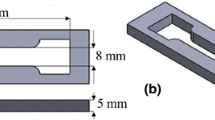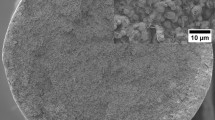Abstract
Rapid investment casting can reduce cost and lead time and enables the manufacturing of more complex geometries compared to the conventional investment casting process. These advantages are offset by stair-stepping, poor burnout characteristics, and ash residue of 3D printed patterns that have a detrimental impact on surface roughness and dimensional tolerances of castings. In this work, we propose a specimen with eleven surface angles and can be 3D printed without supports to explore the effects of burnout temperature and stair-stepping on the cast surface roughness and tolerances. Patterns are 3D printed from acrylonitrile butadiene styrene (ABS), polylactic acid (PLA), and polyvinyl butyral (PVB) using fused filament fabrication. Three specimens of each material are invested in the ceramic shell, burned out at temperatures of 700, 900, and 1100 °C, and A319 alloy is cast subsequently. The original specimens and their castings are optically scanned to compare their roughness distributions and dimensional tolerances. The surface roughness average (Ra) is found to be evenly distributed for all face angles and burnout temperatures with an average value of 5 μm. Texture aspect ratio parameter (Str) shows that PVB-derived castings retain the as-3D printed surface texture better than ABS. Laser scans show that PVB patterns exert the lowest thermal expansion stress on the ceramic shell, while ABS is the worst case, evident by extensive mold cracking.















Similar content being viewed by others
Availability of data and material
The authors will provide relevant documentation and/or data upon request.
Code availability
Not applicable.
Abbreviations
- ABS:
-
Acrylonitrile butadiene styrene
- FFF:
-
Fused filament fabrication
- IC:
-
Investment casting
- PLA:
-
Polylactic acid
- PVB:
-
Polyvinyl butyral
- Ra:
-
Roughness average
- RIC:
-
Rapid investment casting
- SLA:
-
Stereolithography apparatus
- SLS:
-
Selective laser sintering
- Str:
-
Texture aspect ratio, area roughness parameter
References
Beeley PR, Smart RF (1995) Investment casting. Institute of Materials, London
Kumar P, Ahuja IS, Singh R (2016) Effect of process parameters on surface roughness of hybrid investment casting. Prog Addit Manuf 1(1):45–53
Singh S, Singh R (2017) Some investigations on surface roughness of aluminium metal composite primed by fused deposition modeling-assisted investment casting using reinforced filament. J Braz Soc Mech Sci Eng 39(2):471–479
Brisotti MB, Garcia LDFR, Consani S, Pires-de-Souza FDCP (2009) Influence of investment granulometry on the castability and surface roughness of castings obtained with Ni/Cr alloys. Mater Res 12:169–172
Rath S, Baumeister G, Hausselt J (2006) Investments for casting micro parts with base alloys. Microsyst Technol 12(3):258–266
Jiang J, Liu XY (2007) Dimensional variations of castings and moulds in the ceramic mould casting process. J Mater Process Technol 189(1–3):247–255
Singh S, Singh R (2016) Fused deposition modelling based rapid patterns for investment casting applications: a review. Rapid Prototyp J 22(1):123–143
Kang JW, Ma QX (2017) The role and impact of 3D printing technologies in casting. China Foundry 14(3):157–168
Chhabra M, Singh R (2011) Rapid casting solutions: a review. Rapid Prototyp J 17(5):328–350
Reeves PE, Cobb RC (1997) Reducing the surface deviation of stereolithography using in-process techniques. Rapid Prototyp J 3(1):20–31
Di Angelo L, Di Stefano P, Marzola A (2017) Surface quality prediction in FDM additive manufacturing. Int J Adv Manuf Technol 93(9):3655–3662
Ahn D, Kim H, Lee S (2009) Surface roughness prediction using measured data and interpolation in layered manufacturing. J Mater Process Technol 209(2):664–671
Mueller T, Tanner C. Improvements in the burnout process for printed patterns. Investment Casting Institute, Montvale. https://www.investmentcasting.org/uploads/8/1/9/8/81988734/18_mueller.docx.pdf
Ahn D, Kweon JH, Kwon S, Song J, Lee S (2009) Representation of surface roughness in fused deposition modeling. J Mater Process Technol 209(15–16):5593–5600
Tiwary VK, Arunkumar P, Deshpande AS, Rangaswamy N (2019) Surface enhancement of FDM patterns to be used in rapid investment casting for making medical implants. Rapid Prototyp J 25(5):904–914
Cheah CM, Chua CK, Lee CW, Feng C, Totong K (2005) Rapid prototyping and tooling techniques: a review of applications for rapid investment casting. Int J Adv Manuf Technol 25(3):308–320
Singh J, Singh R, Singh H (2018) Surface roughness prediction using Buckingham’s pi-theorem for SS-316L hip implant prepared as rapid investment casting. Mater Today Proc 5(9):18080–18088
Singh R, Singh G (2014) Investigations for statistically controlled investment casting solution of FDM-based ABS replicas. Rapid Prototyp J 20(3):215–220
Singh R, Singh S, Singh IP, Fabbrocino F, Fraternali F (2017) Investigation for surface finish improvement of FDM parts by vapor smoothing process. Compos B Eng 111:228–234
Mueller T. Evaluation of a low-cost material extrusion printer for investment casting applications. Investment Casting Institute, Montvale. https://www.investmentcasting.org/uploads/8/1/9/8/81988734/tom_mueller.pdf
Meyer A, Mueller T. An evaluation of using a low-cost printer for prototype investment casting patterns, investment casting institute. annual technical exposition St. Louis, 66th Conference & Exposition St. Louis, Missouri. https://www.investmentcasting.org/uploads/8/1/9/8/81988734/66th_annual_tech_conference_and_expo_book.pdf
Wubbena H (2019) Investment casting made easy with desktop 3D printing. PR Newswire, New York
Investment Casting with PolyCast™. Polymaker Application Note. https://polymaker.com/Downloads/Application_Note/PolyCast_Application_Note_V1.pdf
Jesiotr M, Myszka D (2013) Thermal analysis of selected polymer materials for precision casting models. Arch Foundry Eng 13(2 spec.):61–64
Hafsa MN, Ibrahim M, Wahab M, Zahid MS (2014) Evaluation of FDM pattern with ABS and PLA material. Appl Mech Mater 465:55–59
Yao WL, Leu MC (2000) Analysis and design of internal web structure of laser stereolithography patterns for investment casting. Mater Des 21(2):101–109
Yao WL, Leu MC (1999) Analysis of shell cracking in investment casting with laser stereolithography patterns. Rapid Prototyp J 5(1):12–20
Alfred TS (2000) Investment casters discuss RP ceramic shell strength. Mod em Casting 1:38–40
Geometrical product specifications (GPS) — Surface texture: Profile — Part 2: Terms, definitions and surface texture parameters (ISO 21920-2:2021). https://www.iso.org/standard/72226.html
Eustathopoulos N, Nicholas MG, Drevet B (1999) Wettability at high temperatures. Elsevier, Amsterdam
Marumo C (1975) Reactions and wetting behavior in the molten aluminum-fused silica system. https://escholarship.org/content/qt0632m1x6/qt0632m1x6.pdf
Campbell J (1995) Review of fluidity concepts in casting. Cast Metals 7(4):227–237
Molina JM, Voytovych R, Louis E, Eustathopoulos N (2007) The surface tension of liquid aluminium in high vacuum: the role of surface condition. Int J Adhes Adhes 27(5):394–401
Dezellus O, Eustathopoulos N (2010) Fundamental issues of reactive wetting by liquid metals. J Mater Sci 45(16):4256–4264
Unwin J, Coldwell MR, Keen C, McAlinden JJ (2013) Airborne emissions of carcinogens and respiratory sensitizers during thermal processing of plastics. Ann Occup Hyg 57(3):399–406
Turner A, Arnold R, Williams T (2020) Weathering and persistence of plastic in the marine environment: lessons from LEGO. Environ Pollut 262:114299
Morão A, De Bie F (2019) Life cycle impact assessment of polylactic acid (PLA) produced from sugarcane in Thailand. J Polym Environ 27(11):2523–2539
Brendgen R, Graßmann C, Grethe T, Mahltig B, Schwarz-Pfeiffer A (2021) Coatings with recycled polyvinyl butyral on polyester and polyamide mono-and multifilament yarns. J Coat Technol Res 18(3):819–829
Dhaliwal AK, Hay JN (2002) The characterization of polyvinyl butyral by thermal analysis. Thermochim Acta 391(1–2):245–255
Acknowledgements
The authors thank Dr. M. Papini for the use of the high-resolution optical surface scanners and software enabling accurate roughness analyses.
Funding
This work was supported by the Natural Sciences and Engineering Research Council of Canada (NSERC), RGPIN-2018–04144.
Author information
Authors and Affiliations
Contributions
KoF: conceptualization, methodology, validation, formal analysis, investigation, writing—original draft, and writing—review and editing. KaF: resources, writing—original draft, writing—review and editing, supervision, project administration, and funding acquisition. CR: methodology, writing—review and editing, and project administration.
Corresponding author
Ethics declarations
Competing interests
The authors declare no competing interests.
Additional information
Publisher's Note
Springer Nature remains neutral with regard to jurisdictional claims in published maps and institutional affiliations.
Rights and permissions
About this article
Cite this article
Fedorov, K., Fayazbakhsh, K. & Ravindran, C. Surface roughness and dimensional tolerances in A319 alloy samples produced by rapid investment casting process based on fused filament fabrication. Int J Adv Manuf Technol 119, 4423–4437 (2022). https://doi.org/10.1007/s00170-021-08644-5
Received:
Accepted:
Published:
Issue Date:
DOI: https://doi.org/10.1007/s00170-021-08644-5




